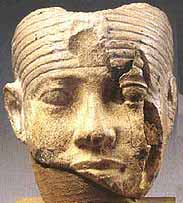According to the Book of Exodus, it is the same Pharaoh, ‘whose daughter adopted three-month-old Moses’ (http://www.biblicalchronologist.org/answers/exodus_egypt.php) and who ‘died when Moses was nearly 80 years old’ (ibid). This means that this Pharaoh must have ruled longer then nearly 80 years. Such a long reign by a mortal human Pharaoh inevitably disqualifies almost all Pharaohs in the real history of Egypt, except for Pepy II, who ‘is traditionally thought to have governed the country for ninety-four years’ (ibid). The name of Pepy (or Pepi) II can be found as the fifth Pharaoh of the 6th Dynasty, who allegedly ruled between 2246 and 2152 B. C. E. The 6th Dynasty has a couple of Pharaohs after the long reign of Pepy II, however, both of them, Merenre II and Nitocris ‘are only known through the (Abydos) king-lists and Manetho (the 30th Dynasty historian). No known monuments give their names and they are not even mentioned in inscriptions of high officials’ (http://www.ancient-egypt.org/index.html). As for these successors of the long reigned Pharaoh, following trivial but supplemental information can be found: ‘The Abydos king-list mentions a Merenre II (also called Antiemdjaf)…, who reigned for only a single year’ (http://www.biblicalchronologist.org/answers/exodus_egypt.php) and he ‘would have been married to Queen Nitocris, who according to Manetho was the last Sixth Dynasty ruler’ (ibid). Now, at least these findings could secure a clue for connecting the history of ancient Egypt and the Book of Exodus, both of which should provide a situation where, ‘an extremely long reign is followed by a very short reign’ (ibid).
The fact that the names of both successors of Pepy II are only known in the Abydos king-lists implies how miserable their reigns would have been. Quoting from Nicholas Grimal (1993), the author(s) of the web site referred above further continues to establish a following strong case:
‘The Biblical account of the ten plagues is quite detailed. It describes the pollution of the water supply, and devastation of the livestock and vegetation of the land. The Israelites left, depriving the land of its slave labor, and they carried away much of the land’s wealth in the form of silver, gold, and clothing [Exodus 12:36]. Also, the army and the Pharaoh were drowned in the “Red Sea,” leaving the country with weakened defences… Grimal says: “The Old Kingdom ended with a period of great confusion… It was the collapse of the whole society, and Egypt itself had become a world in turmoil, exposed to the horrors of chaos which was always waiting for the moment when the personification of the divine being – the Pharaoh – neglected his duties or simply disappeared… This time period was characterized by famine, an expected result of the plagues… This famine was limited to the Nile valley… (Egypt’s foreign trade ceased and Egyptian mining in the Sinai peninsula) also seems to have been abandoned”… The nation of Egypt had obviously suffered a severe blow—as one would expect from what the Bible tells us of the events accompanying the Exodus. –Reference: Grimal, Nicolas (1993), A History of Ancient Egypt Cambridge, MA: Blackwell Publishers Inc.’ (ibid).
 |
| Pepy II (?) |
For reading the text in full: http://wrex2009.wordpress.com/2013/04/15/the-exodus-in-the-history-of-ancient-egypt/


